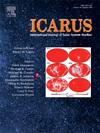The impact of whistler mode waves on Jupiter's auroral intensity distribution
IF 3
2区 物理与天体物理
Q2 ASTRONOMY & ASTROPHYSICS
引用次数: 0
Abstract
The diffuse aurora at Jupiter has been studied, and the intensities of its ultraviolet diffuse auroral emissions have been measured. Electrons trapped on closed magnetic field lines are diffused into the atmospheric loss cone through resonant interactions with whistler-mode waves. Observational data collected by the Juno orbiter have been utilized in this study. The precipitation flux of diffused particles into the atmospheric loss-cone has been calculated for five distinct L-shells L = 10, 12, 15, 18, and 20. Additionally, the volume excitation and ionization rates in Jupiter's atmosphere have been determined using the Analytical Yield Spectrum (AYS) approach for electron energy degradation. The calculations have been performed for H Lyman-α from atomic H excitation, H Lyman-α from dissociative excitation of molecular H₂, and the Lyman and Werner bands from H₂ excitation. The height-integrated volume excitation rates yield the intensities of H Lyman-α, Lyman, and Werner bands. At two L-shells, L = 10 and (L = 20), the calculated diffuse auroral intensities for various cases—H Lyman-α, Lyman, and Werner bands—are found to be 97 kR (12 kR), 490 kR (63 kR), and 520 kR (67 kR), respectively. The intensities obtained in this study are approximately 4 to 20 times higher than those estimated in a previous study involving electron cyclotron harmonic (ECH) waves. The electron density in Jupiter's atmosphere has been calculated, with the peak density reaching 2.3 × 107 cm−3 at an altitude of 600 km. In contrast, a previous study involving ECH waves found the peak density to be 1 × 107 cm−3. Outcomes are discussed.
吹哨波对木星极光强度分布的影响
人们研究了木星的漫射极光,并测量了其紫外线漫射极光的强度。被困在闭合磁场线上的电子通过与哨子模式波的共振相互作用扩散到大气损失锥中。这项研究利用了朱诺号轨道飞行器收集的观测数据。在L = 10、12、15、18和20的5种不同的L壳层中,计算了扩散粒子进入大气损失锥的降水通量。此外,利用电子能量降解的分析产率谱(AYS)方法确定了木星大气中的体积激发和电离率。计算了原子H激发下的H Lyman-α、分子H₂解离激发下的H Lyman-α以及H₂激发下的Lyman和Werner能带。高度积分体积激发率产生H Lyman-α、Lyman和Werner波段的强度。在L = 10和(L = 20)两个L壳层,分别计算出h Lyman-α带、Lyman带和Werner带的散射极光强度分别为97 kR (12 kR)、490 kR (63 kR)和520 kR (67 kR)。本研究获得的强度大约是先前涉及电子回旋谐波(ECH)波的研究估计的4至20倍。计算了木星大气中的电子密度,在海拔600千米处,电子密度峰值达到2.3 × 107 cm−3。相比之下,先前涉及ECH波的研究发现峰值密度为1 × 107 cm−3。讨论了结果。
本文章由计算机程序翻译,如有差异,请以英文原文为准。
求助全文
约1分钟内获得全文
求助全文
来源期刊

Icarus
地学天文-天文与天体物理
CiteScore
6.30
自引率
18.80%
发文量
356
审稿时长
2-4 weeks
期刊介绍:
Icarus is devoted to the publication of original contributions in the field of Solar System studies. Manuscripts reporting the results of new research - observational, experimental, or theoretical - concerning the astronomy, geology, meteorology, physics, chemistry, biology, and other scientific aspects of our Solar System or extrasolar systems are welcome. The journal generally does not publish papers devoted exclusively to the Sun, the Earth, celestial mechanics, meteoritics, or astrophysics. Icarus does not publish papers that provide "improved" versions of Bode''s law, or other numerical relations, without a sound physical basis. Icarus does not publish meeting announcements or general notices. Reviews, historical papers, and manuscripts describing spacecraft instrumentation may be considered, but only with prior approval of the editor. An entire issue of the journal is occasionally devoted to a single subject, usually arising from a conference on the same topic. The language of publication is English. American or British usage is accepted, but not a mixture of these.
 求助内容:
求助内容: 应助结果提醒方式:
应助结果提醒方式:


